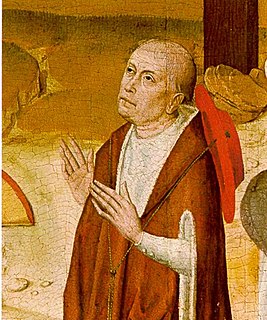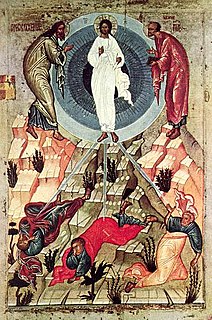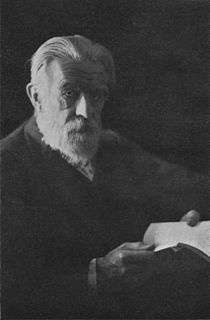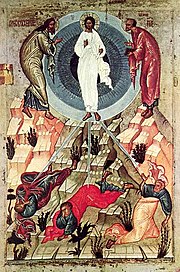
Kabbalah is an esoteric method, discipline, and school of thought in Jewish mysticism. A traditional Kabbalist in Judaism is called a Mequbbāl. The definition of Kabbalah varies according to the tradition and aims of those following it, from its religious origin as an integral part of Judaism, to its later adaptations in Western esotericism. Jewish Kabbalah is a set of esoteric teachings meant to explain the relationship between the unchanging, eternal God–the mysterious Ein Sof – and the mortal, finite universe. It forms the foundation of mystical religious interpretations within Judaism.

Nicholas of Cusa, also referred to as Nicholas of Kues and Nicolaus Cusanus, was a German philosopher, theologian, jurist, mathematician and astronomer. One of the first German proponents of Renaissance humanism, he made spiritual and political contributions in European history. A notable example of this is his mystical or spiritual writings on "learned ignorance," as well as his participation in power struggles between Rome and the German states of the Holy Roman Empire.

Jakob Böhme was a German philosopher, Christian mystic, and Lutheran Protestant theologian. He was considered an original thinker by many of his contemporaries within the Lutheran tradition, and his first book, commonly known as Aurora, caused a great scandal. In contemporary English, his name may be spelled Jacob Boehme; in seventeenth-century England it was also spelled Behmen, approximating the contemporary English pronunciation of the German Böhme.
William Law was a Church of England priest who lost his position at Emmanuel College, Cambridge when his conscience would not allow him to take the required oath of allegiance to the first Hanoverian monarch, King George I. Previously William Law had given his allegiance to the House of Stuart and is sometimes considered a second-generation non-juror. Thereafter, Law first continued as a simple priest (curate) and when that too became impossible without the required oath, Law taught privately, as well as wrote extensively. His personal integrity, as well as his mystic and theological writing greatly influenced the evangelical movement of his day as well as Enlightenment thinkers such as the writer Dr Samuel Johnson and the historian Edward Gibbon. In 1784 William Wilberforce (1759–1833), the politician, philanthropist and leader of the movement to stop the slave trade, was deeply touched by reading William Law's book A Serious Call to a Devout and Holy Life (1729). Law's spiritual writings remain in print today.

Christian mysticism refers to mystical practices and theory within Christianity. Mysticism is not so much a doctrine as a method of thought. It has often been connected to mystical theology, especially in the Catholic Church and Orthodox Christianity.

Angelus Silesius, born Johann Scheffler and also known as Johann Angelus Silesius, was a German Catholic priest and physician, known as a mystic and religious poet. Born and raised a Lutheran, he adopted the name Angelus and the epithet Silesius ("Silesian") on converting to Catholicism in 1653. While studying in the Netherlands, he began to read the works of medieval mystics and became acquainted with the works of the German mystic Jacob Böhme through Böhme's friend, Abraham von Franckenberg. Silesius's mystical beliefs caused tension between him and Lutheran authorities and led to his eventual conversion to Catholicism. He took holy orders under the Franciscans and was ordained a priest in 1661. Ten years later, in 1671, he retired to a Jesuit house where he remained for the rest of his life.
Rufus Matthew Jones was an American religious leader, writer, magazine editor, philosopher, and college professor. He was instrumental in the establishment of the Haverford Emergency Unit. One of the most influential Quakers of the 20th century, he was a Quaker historian and theologian as well as a philosopher. He is the only person to have delivered two Swarthmore Lectures.

Johannes Tauler OP was a German mystic, a Roman Catholic priest and a theologian. A disciple of Meister Eckhart, he belonged to the Dominican order. Tauler was known as one of the most important Rhineland mystics. He promoted a certain neo-platonist dimension in the Dominican spirituality of his time.

Ernst Eduard vom Rath was a German diplomat. He is remembered for his assassination in Paris in 1938 by a Polish Jewish teenager, Herschel Grynszpan, which provided a pretext for the Kristallnacht, "The Night of Broken Glass".
Nicholas of Basel was a prominent member of the Beghard community, who travelled widely as a missionary and propagated the teachings of his sect.

Mystici corporis Christi is a papal encyclical issued by Pope Pius XII on 29 June 1943 during World War II. It is principally remembered for its statement that the Mystical Body is identical with the Roman Catholic Church, repeated by Pius XII in Humani generis (1950) in response to dissension. According to Mystici corporis, to be truly (reapse) a member of the Mystical Body one must be a member of the Roman Catholic Church. Other Christians who erred in good faith could be unsuspectingly united to the Mystical Body by an unconscious desire and longing.

Friedrich von Hügel was an influential Austrian Roman Catholic layman, religious writer, Modernist theologian and Christian apologist.

The Friends of God was a medieval mystical group of both ecclesiastical and lay persons within the Catholic Church and a center of German mysticism. It was founded between 1339 and 1343 during the Avignon Papacy of the Western Schism, a time of great turmoil for the Catholic Church. The Friends of God were originally centered in Basel, Switzerland and were also fairly important in Strasbourg and Cologne. Some late-nineteenth century writers made large claims for the movement, seeing it both as influential in fourteenth-century mysticism and as a precursor of the Protestant Reformation. Modern studies of the movement, however, have emphasised the derivative and often second-rate character of its mystical literature, and its limited impact on medieval literature in Germany.

Rulman Merswin was a German mystic, leader for a time of the Friends of God.

William A. Earle was a twentieth-century American philosopher.

Eckhart von Hochheim, commonly known as Meister Eckhart or Eckehart, was a German theologian, philosopher and mystic, born near Gotha in the Landgraviate of Thuringia in the Holy Roman Empire.

Mysticism is popularly known as becoming one with God or the Absolute, but may refer to any kind of ecstasy or altered state of consciousness which is given a religious or spiritual meaning. It may also refer to the attainment of insight in ultimate or hidden truths, and to human transformation supported by various practices and experiences.
Wilhelm Rath was a German writer, translator, bio-dynamic farmer and anthroposophist. He is best known for his research and translations of certain medieval mystics, notably the Friend of God from the Oberland, Bernard Silvestris, Alanus ab Insulis and John of Hildesheim.
Sister-books is the term for a group of texts in the medieval literature. These works were written by Dominican nuns in the first half of the fourteenth century in South Germany and Switzerland. They relate the mystical experiences of sisters within the monastery, and were influential in the development of medieval mysticism.

Anna Maria von Baden-Durlach was a German poet and painter. She was a daughter of Margrave Georg Friedrich von Baden.












